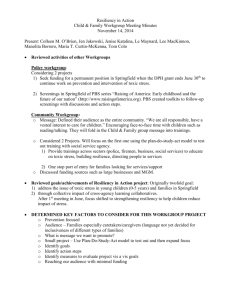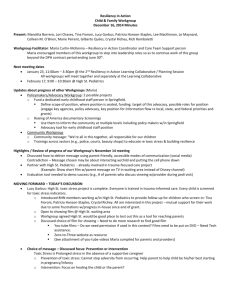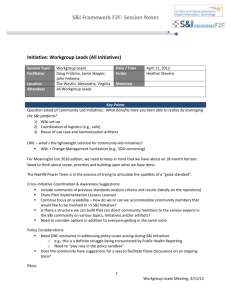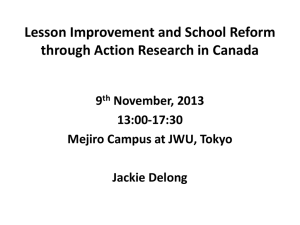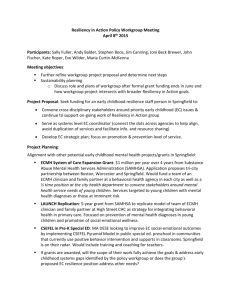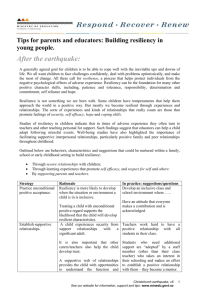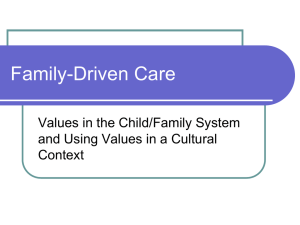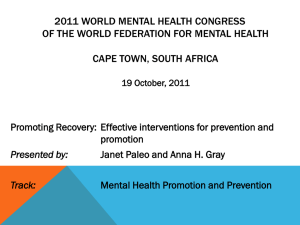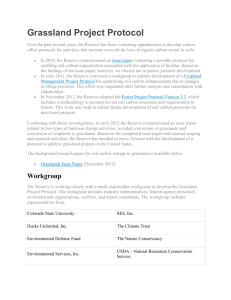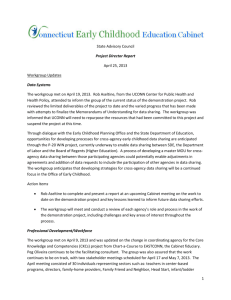Joint Meeting of the Modeling Subcommittee and Sediment Workgroup
advertisement
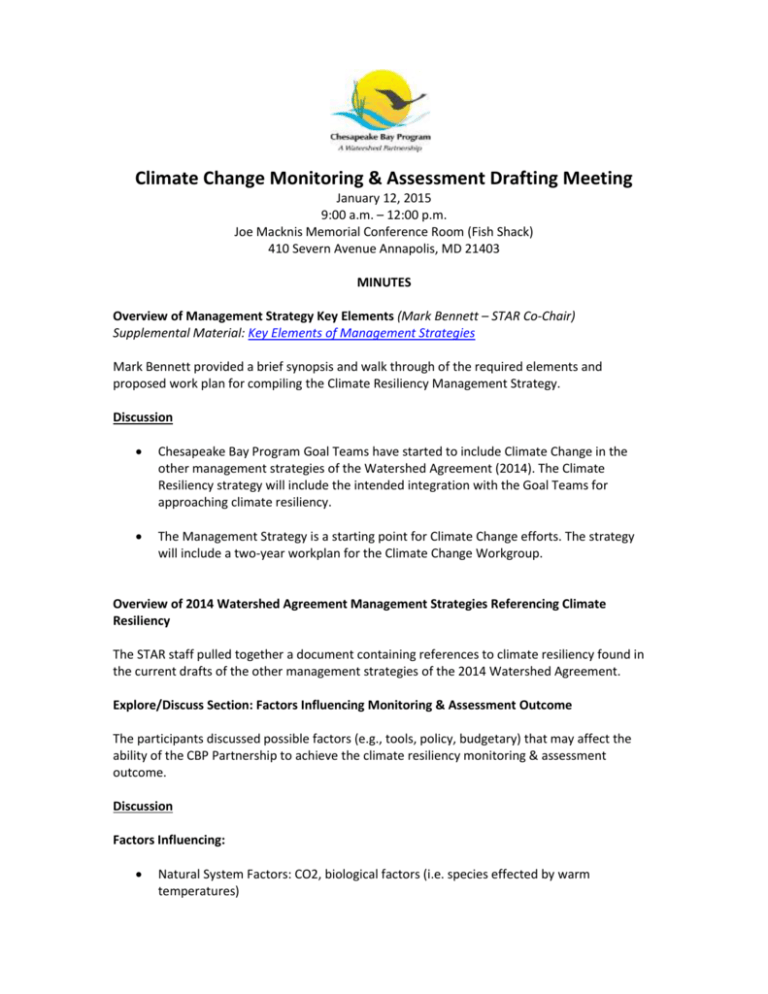
Climate Change Monitoring & Assessment Drafting Meeting January 12, 2015 9:00 a.m. – 12:00 p.m. Joe Macknis Memorial Conference Room (Fish Shack) 410 Severn Avenue Annapolis, MD 21403 MINUTES Overview of Management Strategy Key Elements (Mark Bennett – STAR Co-Chair) Supplemental Material: Key Elements of Management Strategies Mark Bennett provided a brief synopsis and walk through of the required elements and proposed work plan for compiling the Climate Resiliency Management Strategy. Discussion Chesapeake Bay Program Goal Teams have started to include Climate Change in the other management strategies of the Watershed Agreement (2014). The Climate Resiliency strategy will include the intended integration with the Goal Teams for approaching climate resiliency. The Management Strategy is a starting point for Climate Change efforts. The strategy will include a two-year workplan for the Climate Change Workgroup. Overview of 2014 Watershed Agreement Management Strategies Referencing Climate Resiliency The STAR staff pulled together a document containing references to climate resiliency found in the current drafts of the other management strategies of the 2014 Watershed Agreement. Explore/Discuss Section: Factors Influencing Monitoring & Assessment Outcome The participants discussed possible factors (e.g., tools, policy, budgetary) that may affect the ability of the CBP Partnership to achieve the climate resiliency monitoring & assessment outcome. Discussion Factors Influencing: Natural System Factors: CO2, biological factors (i.e. species effected by warm temperatures) Human System Factors: Development Knowledge of the system and how climate effects the system The magnitude of effort and cost Natural system factors should be folded under the Human system factors, the “sufficient knowledge” bullet of how climate impacts the system (i.e., understanding sea level rise, precipitation change, etc.) Wind - there are a suite of papers regarding the modulating effects of changes in wind direction and intensity on explaining dissolved oxygen (hypoxia) patterns in the Bay. Content to include with factors: There are many variables for each of the listed factors influencing. Long-term monitoring and assessment is unknown for many of those variables. How are the “factors influencing” going to challenge the goals? We don’t have the data to explain all the possible impacts of the factors influencing, therefore how do we factor in uncertainty? o Monitoring can allow for adaptive management of the strategy, and future recommendations to the other Goal Teams in regards to climate change. o How can the monitoring program adapt to climate change in the future? This is important to reflect in the strategy. What about measurement protocols or formal indicators for climate change? o Identify what is essential for monitoring climate for the Chesapeake Bay, are we collecting that data? o Ultimately, there is a need for uniform guidance on how to factor climate change into decision-making processes (i.e., siting and design guidance for onthe-ground restoration projects) The data collected by different agencies must be comparable and accessible. Define the use of protocols in this document. o Definition: Establishing monitoring protocols to provide uniformed guidelines for monitoring and assessment. The role and responsibilities of the Climate Change Workgroup and the Climate Coordinator should be reflected in the strategy. A whole set of external groups are working on different facets of climate change monitoring, Including the Chesapeake Bay Sentinel Site Cooperative (NOAA Sentinel Site Program). It is important to incorporate the role of models in the management strategy. Monitoring should be divided into two components, stressors and ecosystem responses that need to be monitored, and also the effects of restoration projects on resilience. This could be the difference between long-term and short-term monitoring. When monitoring for evaluation of adaptation, it is important that monitoring and modeling are closely tied to show the recovery rate (detection) for adaptation. What is the timeframe for the Climate Resiliency Management Strategy? Most of the other outcomes are written to 2025, however aspects of climate change are traditionally monitored to a 100 year timeframe. o The strategy may have to look at both (2025 and further in the future) in order to respond to the needs of the managers carrying out the other outcomes. o The further the projections are into the future the larger the uncertainty. Include a paragraph in the factors influencing section explaining that the timeframe may change depending on the impacts/factors influencing. Explore/Discuss Section: Management Approach The participants outlined a general approach for implementation of the overall management strategy; responsibilities of GIT liaisons; and, roles for and/or collaborations with external organizations. An Overview of the Management Approach 1) Establish an assessment framework, driven by management questions, which link impacts of climate change to the ability to achieve the Watershed Agreement outcomes. 2) Determine if the monitoring data being collected and the tools that are available can answer questions that fill out the assessment framework. 3) Identify the forecast and projection models necessary to carry out the assessments. Which projections and forecasts are being used, and what are the basis for those models? Determine which model(s) output should be adopted by the Chesapeake Bay Program Partnership to use across all goals. 4) Articulate a process for establishing baselines for climate change aspects to be monitored. 5) Define which aspects of climate change are the highest priority across the goals of the Watershed Agreement. 6) Outline an integrated research monitoring & assessment agenda for priority aspects of climate change. 7) Reassess the baselines and priorities biannually. Content to include in the Management Approach Section: Recommend a periodic update of the Climate Change STAC Report: State-of-the-Science Review and Recommendations The new Climate Change Workgroup under STAR is developing the Climate Resiliency Management Strategy. The strategy should include an overview of how the workgroup will function. ACTION: Send out the Toxics MS as a reference of what an assessment based strategy could look like. The strategy should outline a prioritization process – what are the roles of the Climate Change Workgroup and the Goal Implementation Teams in the process. Education and Outreach – targeting local governments, environmental literacy. o Illustrate that reducing emissions globally has benefits to the Bay. A participant recommended that the prioritization process include what the current research questions are (i.e. climate academic centers). A participant recommended grouping elements of the strategy into 1) needed science information/knowledge (including monitoring and modeling), 2) building capacity to get needed science knowledge (including monitoring and modeling), and 3) things that we need to consider (i.e. stakeholder concerns/issues) to craft realistic management strategies. o Identifying needed science would include: "Establishing monitoring and assessment protocols" and an "outlined research agenda". As the monitoring network works to fill in monitoring & assessment gaps, assessments can use the best science available, but work to engage stakeholders to understand the need to be flexible to change and adapt as we learn more. The purpose of the biennial workplan is to re-evaluate based on what’s learned and evaluate what is possible in a two-year timeframe. It is important to factor climate change into all the other management strategies, and outline the role of the climate change workgroup. The climate change workgroup will not be able to address all other outcomes immediately, however, it is important to acknowledge the plan to address the needs of the Goal Teams through a prioritization process. How are the modeling workgroup and climate change workgroup going to integrate climate efforts? o In a peer-review fashion the workgroups will bring in the respective science communities. Timeline & Writing Roles and Responsibilities Monitoring & Assessment Drafting Team Conference Call January 22nd, 2015 @ 8AM Drafting Team Volunteers (Contributions outlined during the January 22nd Call) Mark Bennett – Management Approach & Local Engagement Sections Raymond Najjar – Current Efforts & Assessment Section Susan Julius Peter Murdoch – Early Reviewer Kurt Johnson Nicole Carlozo – Factors Influencing Section Cynthia Stahl – Management Approach Section Jenny Allen – Factors Influencing Section LEADERSHIP Mark Bennett (STAR Co-Chair) Zoe Johnson (Workgroup Chair) Lea Rubin (STAR Staff) AFFILIATION USGS MDNR CRC/CBPO PARTICIPANTS Andrew Muller Chris Becraft Chris Spaur Cynthia Stahl Diana Muller Don Smith Donna Bilkovic Jenny Allen Kurt Johnson Lori Mohr Marel King Marian Norris Michelle Hamor Mike Wilson Nicole Carlozo Peter Murdock Peter Tango Ray Najjar Rich Batiuk Susan Julius Tanya Spano AFFILIATION US Naval Academy MDNR USACE EPA South River Federation VADEQ VIMS MDNR USFWS PA DEP CBC NPS USACE NRCS MDNR USGS USGS/CBPO PSU EPA/CBPO EPA WASHCOG EMAIL mrbennet@usgs.gov zoe.johnson@maryland.gov lrubin@chesapeakebay.net
